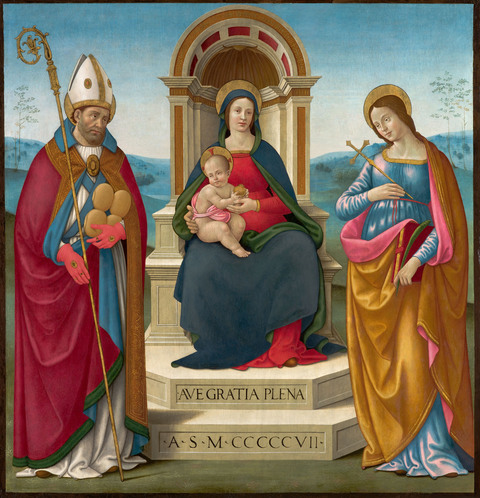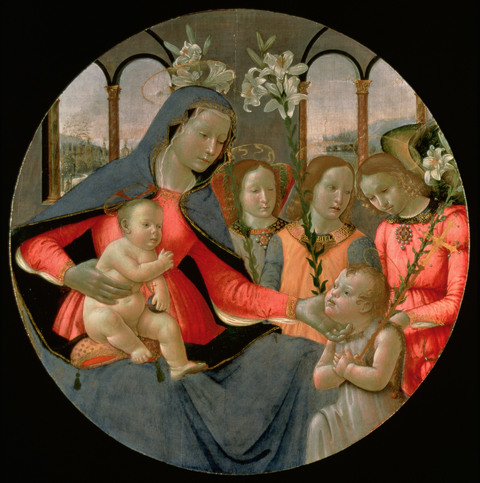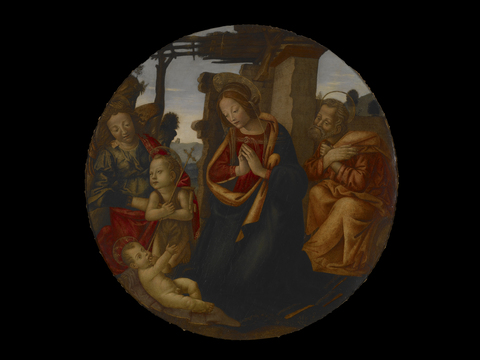Marks, Inscriptions, and Distinguishing Features
None
Entry


Author
Provenance
Baron Karl Kuffner (1847–1924) de Dioszegh (or Diószeg), near Bratislava;
Baron Raoul Kuffner (1886–1961), Dioszegh, near Bratislava, later New York;20
By inheritance to his widow, the painter Tamara de Lempicka (1898–1980).
Elizabeth M. Drey of (Paul Drey Gallery, New York);21
Edith Whitehill Clowes (1885–1967), Indianapolis, in 1964;
The Clowes Fund, Indianapolis, from 1964–2004, and on long-term loan to the Indianapolis Museum of Art since 1971 (C10076);
Given to the Indianapolis Museum of Art, now the Indianapolis Museum of Art at Newfields, in 2015.
Exhibitions
Allen R. Hite Art Institute, Louisville, KY, 1964, Italian Paintings: 1300–1600.
References
Italian Paintings: 1300–1600, exh. cat. (Louisville: Allen R. Hite Art Institute, University of Louisville Library, 1964), 17n1 (unpaginated, cover illustration and inside cover).
The Indianapolis Star Sunday Magazine, 19 December 1965 (cover illustration and inside cover information);
Ian Fraser, A Catalogue of the Clowes Collection (Indianapolis: Indianapolis Museum of Art, 1973), 24–25.
Notes
-
These works are The Ascension of the Virgin in the Baroncelli Chapel in the Basilica of Santa Croce in Florence (1485–90), and Sts. Gemignanus, Lucy, and Nicholas of Bari (left wall) and the Four Doctors of the Church (ceiling) in the San Bartolo Chapel in the church of Sant’Agostino at San Gimignano (1500). ↩︎
-
On Bastiano Mainardi, see Géza de Fràncovich, “Sebastiano Mainardi,” Cronache d’arte 4 (1927): 169–93, 256–70; Lisa Venturini, “Bastiano Mainardi, pittore di San Gimignano e altri problemi di pittura fiorentina tra la fine del Quattrocento e l’inizio del Cinquecento,” laurea thesis, Università degli studi di Firenze, 1989; Lisa Venturini, “Tre tabernacoli di Sebastiano Mainardi,” Kermes 15 (1992): 41–48; Lisa Venturini, “Il Maestro del 1506: La tarda attività di Bastiano Mainardi,” Studi di storia dell’arte 5–6 (1994–95): 123–83; Alessio Assonitis, Bastiano Mainardi: Painter of Altarpieces in Renaissance Tuscany (Indianapolis: Indianapolis Museum of Art, 2011). ↩︎
-
Lisa Venturini, “Modelli fortunati e produzione in serie,” in Maestri e botteghe: Pittura a Firenze alla fine del Quattrocento, ed. Mina Gregori, Antonio Paolucci, and Cristina Acidini Luchinat (Cinisello Balsamo: Silvana Editoriale, 1992), 147–57; Jean K. Cadogan, “Observations on Ghirlandaio’s Method of Composition,” Master Drawings 22, no. 2 (1984): 159–72, 223–35. ↩︎
-
Frances Ames-Lewis, “Drapery ‘Pattern’ Drawings in Ghirlandaio’s Workshop and Ghirlandaio’s Early Apprenticeship,” The Art Bulletin 63, no. 1 (1981): 49–62; Lisa Venturini, “I Ghirlandaio,” in Maestri e botteghe: Pittura a Firenze alla fine del Quattrocento, ed. Mina Gregori, Antonio Paolucci, and Cristina Acidini Luchinat (Cinisello Balsamo: Silvana Editoriale, 1992), 109–13; Jean K. Cadogan, “Sulla bottega di Ghirlandaio,” Domenico Ghirlandaio, 1449–1494: Atti del convegno internazionale, Firenze, 16–18 ottobre 1994, ed. Wolfram Prinz and Max Seidel (Florence: Centro Di, 1996), 89–96. ↩︎
-
Giorgio Vasari, Le opere di Giorgio Vasari, ed. Gaetano Milanesi, vol. 3 (Florence: G. C. Sansoni Editore, 1880), 276–77. ↩︎
-
Mainardi’s complete oeuvre had to be thoroughly reconsidered after Lisa Venturini correctly identified his birthdate as 1466 rather than a decade earlier, as assumed by Geza de Francovich and Bernard Berenson. ↩︎
-
Nicoletta Pons, “Dipinti a più mani,” in Maestri e botteghe: Pittura a Firenze alla fine del Quattrocento, ed. Mina Gregori, Antonio Paolucci, and Cristina Acidini Luchinat (Cinisello Balsamo: Silvana Editoriale, 1992), 35–44. ↩︎
-
The identification of Mainardi is made on the basis of another portrait that was included in Joachim Expelled from the Temple of 1490 (Florence, Tornabuoni Chapel in Santa Maria Novella), which Vasari identifies as Bastiano. ↩︎
-
Venturini, 1994-95, p.137. ↩︎
-
Geza de Francovich, “Sebastiano Mainardi,” Cronache d’arte 4 (1927): 169–193, 256–70. ↩︎
-
Bernard Berenson, Italian Pictures of the Renaissance: The Florentine School (New York: Phaidon Publishers, 1963), 1:125–128. ↩︎
-
Everett Fahy, Some Followers of Domenico Ghirlandajo (New York: Garland, 1976), 190, 215–219. ↩︎
-
Lisa Venturini, “Bastiano Mainardi, pittore di San Gimignano e altri problemi di pittura fiorentina tra la fine del Quattrocento e l’inizio del Cinquecento,” laurea thesis, Università degli studi di Firenze, 1989; Lisa Venturini, “Tre tabernacoli di Sebastiano Mainardi,” Kermes 15 (1992): 41–48; Lisa Venturini, “Il Maestro del 1506: La tarda attività di Bastiano Mainardi,” Studi di Storia dell’Arte 5–6 (1994–95): 123–183. ↩︎
-
Problems related to Mainardi’s workshop are discussed in Lisa Venturini, “Bastiano Mainardi, pittore di San Gimignano e altri problemi di pittura fiorentina tra la fine del Quattrocento e l’inizio del Cinquecento,” laurea thesis, Università degli studi di Firenze, 1989. ↩︎
-
The more notable pictures that have been attributed to Mainardi and his workshop are Adoration of the Christ Child with Angels Holding a Banner, Rome, Pinacoteca Vaticana (this is a tableau with golden background); Adoration of the Shepherds, Leipzig, Museum der bildenden Künste; Adoration of the Christ Child (without angels and St. John the Baptist), Bergamo, Credito Bergamasco; Adoration of the Christ Child (without angels and St. John the Baptist), location unknown, formerly auctioned at Sotheby’s, New York, 26 January 2006, 281; Adoration of the Christ Child and St. John the Baptist (without angels), Rome, private collection; Adoration of the Christ Child with St. John the Baptist (without angels), Dresden, Gemäldegalerie Alte Meister; Adoration of the Christ Child with St. John the Baptist (without angels), location unknown, formerly in Florence, Costantini collection; Adoration of the Christ Child with St. John the Baptist (without angels and St. Joseph), Art Institute of Chicago; Adoration of the Shepherds, location unknown, formerly Turin, Piccola Casa della Divina Provvidenza; Adoration of the Christ Child (without angels and St. John the Baptist), Prato, private collection; Adoration of the Christ Child (rectangular tableau, without angels and St. John the Baptist), Rohrau, Austria, Graf Harrach'sche Familiensammlung, Schloss Rohrau; and Adoration of the Christ Child with St. John the Baptist (without angels), Rome, private collection; Adoration of the Christ Child (without angels), Florence, Galleria degli Uffizi (Cat. no. 00457516). ↩︎
-
Everett Fahy, “The ‘Master of the Naumburg Madonna,'” Fogg Art Museum Acquisitions (1966–67), 11–18. In this article, Fahy attributes the Clowes tondo to the Master of the Naumburg Madonna. This attribution was confirmed by Nicoletta Pons in Pittori attivi in Toscana dal Trecento al Settecento, ed. Francesca Baldassarri (Florence: Polistampa, 2010), 110-13. The Master of the Naumburg Madonna takes the name from Nettie G. Naumburg, who donated a Virgin and Child with a Bird to the Fogg Art Museum in 1930. This unknown artist, according to Fahy, is the same of the Richmond tondo. ↩︎
-
Everett Fahy, “The ‘Master of the Naumburg Madonna,'” Fogg Art Museum Acquisitions (1966–67), 17. ↩︎
-
The Virginia Museum of Fine Arts attributes this tondo, without providing any documentary proof or stylistic argument, to the Master of the Samaritan Woman. ↩︎
-
Nicoletta Pons, “La fortuna figurativa dell’Adorazione Sassetti di Domenico Ghirlandaio a Santa Trinita,” in Domenico Ghirlandaio, 1449–1494: Atti del convegno internazionale; Firenze, 16–18 ottobre 1994, ed. Wolfram Prinz and Max Seidel (Florence: Centro Di, 1996), 165–74. ↩︎
-
Baron Raoul Kuffner’s parents were avid art collectors, who left their collection to their son. For more information on the Kuffner family, see the Prefatory Note in Parke-Bernet Galleries, Dutch and Flemish Old Masters, Italian Renaissance Paintings…from the Collection of Baron and Baroness Raoul Kuffner de Dioszegh removed from the Picture Gallery at Castle de Dioszegh near Bratislava, sold by their order, 19 November 1948. The Clowes painting was not, however, included in this sale. ↩︎
-
Elizabeth Drey, who ran the Paul Drey Gallery after her husband’s death, does not specifically mention Tamara de Lempicka’s name, but lists Baron Raoul Kuffner as a previous owner; see Bill of Sale from Paul Drey Gallery, 1 July 1964, File C10076, Clowes Registration Archive, Indianapolis Museum of Art at Newfields. ↩︎
